Maintaining your Avant Machine for Unlimited Performance
Avant makes reliable platforms for Tent OX System attachments. But even the best machines require regular maintenance to deliver full-power service for many years. That’s why Scott Woodruff, President of Tent OX, called on Eric Andress, service manager for Avant Tecno USA’s North American operations, to chat about loader maintenance at a recent Tent OX Round-UP Zoom meeting for owners. Follow Eric’s tips and reduce the chance that you’ll ever be caught out while on the job.
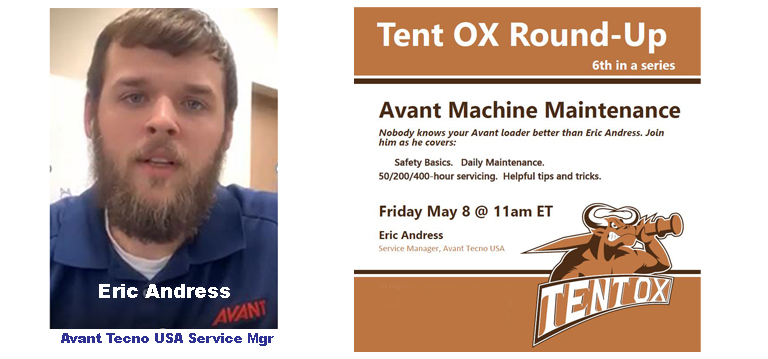
If you’re looking for more detail – including a video tour of the main maintenance points on your Avant loader – please watch the accompanying Youtube video at https://youtu.be/dMlqKgOKQAU
Thanks very much, Eric!
Daily or less frequent maintenance?
When Eric talks about the importance of daily maintenance of an Avant loader, he’s primarily addressing the large percentage of the machines used for agriculture, construction, landscaping and like jobs that are carried out in dirty, dusty conditions. While it is important to know all the daily checkpoints Avant recommends for dirty environments, it is possible to perform less frequent checks for machines used in the cleaner environments in which you operate. But don’t wait if you notice oil leaks or reduced performance. Small oil leaks can lead to bigger ones, and issues like partial loss of power may eventually leave you with a non-working machine for days or longer, and perhaps higher repair bills.
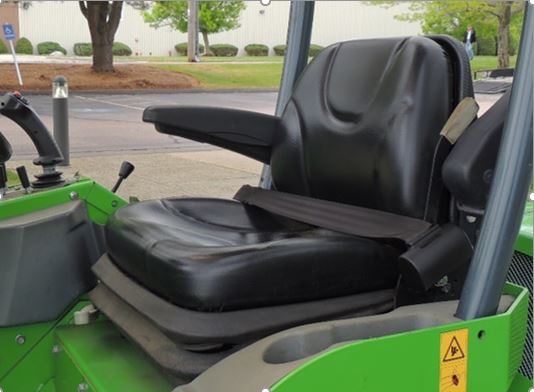
A word about seatbelt use. “Our seatbelt safety system is meant to be used,” Eric points out. “If you’re buckling the belt, but not around your waist, don’t do it that way. Repeated avoidance of wearing a seatbelt will break the mechanism and the machine won’t move.”
And why not use the belt anyway? If you’re carrying the load high and turn hard, you can do a side roll over and be crushed to death without the seatbelt to restrain you.
Scott Woodruff reinforces this point when he says the Avant loader requires operators to do a lot of material handling, often over uneven surfaces and jumping curbs. Lifting from trucks carries a higher risk of tipping the machine over. For instance, if an operator carrying a heavy load high in the air stops short, the loader can tip forward. When the fork hits the ground, the head of an unbelted operator can strike the canopy with potentially deadly results. Make it a company policy to write people up for failing to wear the belt.
Load chart: Key to safe materials handling. Every Avant loader comes with operators manual. And each Avant machine has a prominently affixed, large chart that makes it easy to manage your loads safely. When you’re lifting and extending the boom, you’re adjusting the balance point of the machine forward significantly.
Eric showed this chart from an Avant 640 as an example.
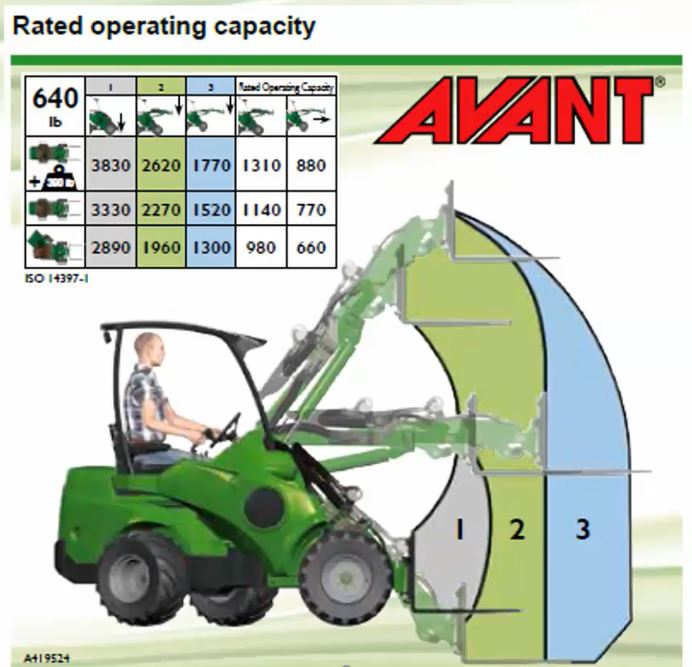
The closer the load is to the end of the boom, the more the machine can lift before beginning to tip. The gray area operating capacity represents lift capacity when using a chain wrapped around front plate of loader. The green area more typical load carrying area using a pallet fork with the load positioned 20 inches in front of the front plate. As you extend the boom, the resulting lower load limits are shown in blue area.
Note that weight limits are reduced when turning the vehicle. Scott recommends that inexperienced users work with small loads to keep safe until they gather enough experience to understand the machine’s lifting, carrying and tipping potential within all of the circumstances they’ll be working.
Carry the weight low. Always. Every Avant loader has a very low center of gravity, and the graphic here shows:
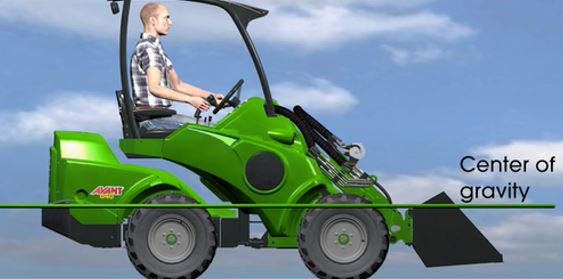
But when you raise the loads you’re carrying, the center of gravity shifts upward to a significant degree, so you need to think of the potential for tipping forward or over when you carry a load incorrectly. When offloading trucks with high decks, lower the boom before traveling to keep the load as close to the ground as possible.
Carrying loads low is critically important. If you are articulating and hit depression in the field, a load carried low will hit the ground sooner rather than later, limiting the machine’s tipping potential.
Also, it’s better to go straight up a slope, not across it. If you’re carrying multiple loads and going straight up, it may add 10 seconds to each run. That’s a lot less time than it will take to return a loader to an upright position after tipping over. Think about how much faster you’re moving materials with Tent OX anyway, and take the little bit of extra time to do it safely.
Proper RPM for efficiency, safety. By design, Avant loaders have a huge efficiency advantage over skid steer machines, whether tracked or wheeled, because they weigh less and their articulated steering requires far less engine power when turning. So when you jump aboard an Avant machine with one of your Tent OX attachments, give some thought to how many revs you really need to do any of the tasks you want to perform. With an Avant, you’ll generally require fewer rpm. That’s a great thing not just for fuel efficiency, but for safety.
The more you increase rpm, the more potential there is for operator error. Hit a bump at higher speeds, and your foot may come off the pedal. Unlike a car, which continues to move forward until you hit the brakes, an articulated loader stops nearly instantly upon pedal release, while the engine is still racing. This can create a hobby horse effect as your foot hits the pedal again. There’s not a huge difference between half throttle and full throttle when it comes to getting a task done, so why not keep the rpms down?
Daily maintenance. Yes, the factory list of things to check every day is quite long. It is intentionally conservative. But at least do it once a week. Fluid levels are vitally important. A minor leak left uncorrected is the first step toward a major leak. If you don’t take a small amount of time to correct the problem when you first notice it, the machine could later fail in the middle of customer’s yard. Check hydraulic oil level with boom fully lifted to make sure it reaches the bottom line on the dipstick. Fluid does expand somewhat. Bottom line is your full mark when cold. If you do overfill somewhat, a little bit of fluid can leak out on a steep slope, no cause for concern.
Check the engine oil dipstick every time you fill with fuel. Eric gave an example of an extreme case of a loader used at a drywall factory. Engine oil was leaking from a cracked oil pan, but with all the manufacturing dust collecting on the leak and being absorbed, the oil hardened. Since the oil level wasn’t checked, the leak went undetected. Eventually the engine locked up from lack of lubrication.
Tire pressures and greasing. Proper tire pressure is another critical, frequent checkpoint. A chart like this that is specific to your own machine/s is located in every manual, This chart is specific to 500 and 600 series loaders:

Low tire pressure in one tire can destabilize the vehicle, offering more potential for danger. When one goes completely flat, it’s enough to get the machine to rock.
Look under the panels. It’s important to do a general visual check of the condition of your loader once a week or so in a tent environment. And it’s a good practice to take the green plastic panels off the loader to see if it’s clean, look for cracks, or parts starting to fail. Small problems can ultimately trigger a big problem if not rectified promptly.
Engine fluid requirements: Eric prefers synthetic oil. Once you get into 755 and higher with Kohler engines, synthetic oils like Mobil Delvac 1 LE are required. That oil is fairly hard to find, so buy in advance to keep it in stock. Kohler offers fluid for sale too. If a non-dealer is doing your oil service, make sure they understand the oil requirements because the wrong oil can lead engine to damage and void your warranty.
Hydraulic oil requirements. Avant’s hydraulic oil requirement is AW46 – most auto parts and hardware stores have it. Non-synthetic oil is required because synthetic can degrade seals. Your owners manual points out grease fittings clearly, but we recommend you watch the accompanying video for this article https://youtu.be/dMlqKgOKQAU for real-time detail as Eric takes you on a tour of the machine.
A word on the importance of greasing. The most important grease fittings for safety’s sake are the two for the articulation joints, located near the lower part of engine between wheels. Older models are a little hard to reach. Ungreased articulation joints on a machine with several thousand hours can result in a costly and time-consuming frame replacement.
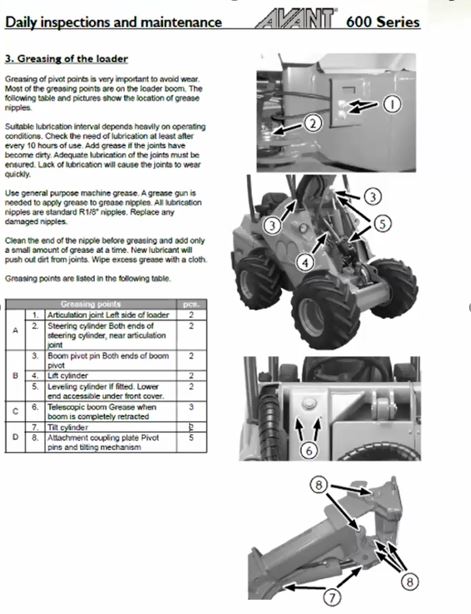
Scott recommends you photocopy the page above – “Greasing of the loader” – directly from your owners manual, laminate it and store it with your grease gun.
You can over-grease, so be sure to wipe off the excess. It’s considered sloppy maintenance to have any of that grease fall on the ground. Check 1:25 in the video that is the companion to this article for Eric’s tour of the interior workings of an Avant loader. He points out grease points, oil filter location and more.
50/200/400-hr services. There are 33 checkpoints for these major service intervals. If you have third party doing service, make sure you bring it up any issues you’ve noticed and have them work through the chart.
Avant filters are required for 50 or 200/400 service. Avant asks you to use them so if you have a problem, Avant has a record that the service has been done. This is very important when and if a warranty claim is placed. Two items most overlooked on the checklist are:
Control valve 50-hr service. The Power Control Valve is a relief valve that allows max drive power without stalling engine. If your machine begins to lose hydraulic power (for instance, it labors to climb hills), it’s time to check that valve with a specialized gauge. Avant dealers have this gauge, but if you do your own service or use a third-party shop you can buy one from Avant for about $600, less than you’ll find it on Amazon. Eric is happy to share instructions on how to use the gauge and make the adjustment
(see Eric’s contact information below).
Fuel tank. You can service the tank without disconnecting the fuel line, which is made extra long for this purpose. Disconnect electrical connector, and when the tank is out, pull the bottom feedline out and put a pan under it. Here’s a picture of the back of the unit showing the gas tank, with the side panels, rear cover and radiator grill removed. It takes only a short time to remove the screws retaining them.
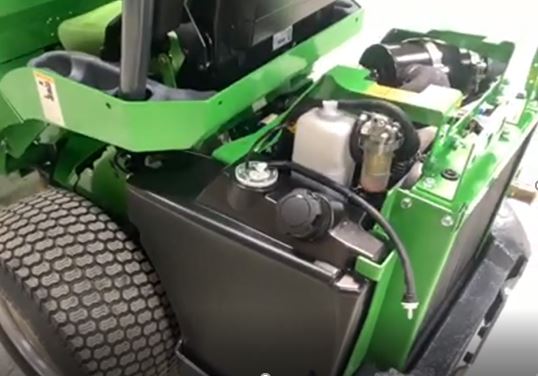
Warranty breakdowns. Eric suggests that most warranty issues should go through Avant dealer unless you can solve the problem on your own. All parts orders have to go through a dealer. If you don’t have one close by, Avant can dropship from Arlington Heights (it does so multiple times a day). Nolt’s, a very large Avant dealer in Pennsylvania, is another source, and they stock more parts than any other dealer. Scott points out that Nolt’s knows Tent OX intimately because they separately handle final assembly and shipping of Tent OX attachments and accessories.
If you don’t have an Avant dealer nearby for warranty work, call Avant in its office in Illinois and they will figure out how to best handle the repair. “You don’t want to dig into an engine problem and void the warranty,” Eric cautions.
Some common service issues
If you’re getting some play in the boom (usually takes years to occur), you may need to adjust shims. Without adjustment it could start to twist and eventually cause a failure. If you have solid tires (not the case for most tent and event companies – Tent OX-sold machines are most likely specified with soft turf tires), more load forces go up and down on boom. If you can move boom up or down or side to side, you need to look at it. Shims can be replaced fairly simply. Usually you can see that the angled edge is worn.
Joystick not working properly. Threaded rods can loosen when people people pull hard on the joystick or grab the joystick when they get in the loader. Usually it’s just a matter of replacing the nylon thread. Don’t let it go unrepaired for long. The nylon thread costs a lot less than a complete assembly replacement.
Throttle adjustment. There’s a 10 mm nut under a black plastic cap. If it slowly works its way down, you can tighten from the top with 10 mm wrench.
Loss of power, usually noticed first when going up hills. This problem can strand the machine if it’s not attended to when you start to notice the problem. It often traces down to a problem with the Power Control Valve, mentioned earlier, and it’s an easy fix. See 2:07 in the video.
Cracked covers. Screws and clips used to secure the covers can occasionally vibrate loose. Missing screws put stress on the cover and cause a crack. When you pull a cover to do a check-up of the engine or other area, check to see if the clips that the screws go into are all there. Keep a few clips and screws in stock and your covers will last longer.
To see the accompanying Youtube video of the session, go to: https://youtu.be/dMlqKgOKQAU
